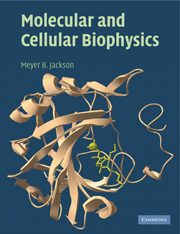Book contents
- Frontmatter
- Contents
- Preface
- Acknowledgements
- Chapter 1 Global transitions in proteins
- Chapter 2 Molecular forces in biological structures
- Chapter 3 Conformations of macromolecules
- Chapter 4 Molecular associations
- Chapter 5 Allosteric interactions
- Chapter 6 Diffusion and Brownian motion
- Chapter 7 Fundamental rate processes
- Chapter 8 Association kinetics
- Chapter 9 Multi-state kinetics
- Chapter 10 Enzyme catalysis
- Chapter 11 Ions and counterions
- Chapter 12 Fluctuations
- Chapter 13 Ion permeation and membrane potential
- Chapter 14 Ion permeation and channel structure
- Chapter 15 Cable theory
- Chapter 16 Action potentials
- Appendix 1 Expansions and series
- Appendix 2 Matrix algebra
- Appendix 3 Fourier analysis
- Appendix 4 Gaussian integrals
- Appendix 5 Hyperbolic functions
- Appendix 6 Polar and spherical coordinates
- References
- Index
Chapter 1 - Global transitions in proteins
Published online by Cambridge University Press: 24 May 2010
- Frontmatter
- Contents
- Preface
- Acknowledgements
- Chapter 1 Global transitions in proteins
- Chapter 2 Molecular forces in biological structures
- Chapter 3 Conformations of macromolecules
- Chapter 4 Molecular associations
- Chapter 5 Allosteric interactions
- Chapter 6 Diffusion and Brownian motion
- Chapter 7 Fundamental rate processes
- Chapter 8 Association kinetics
- Chapter 9 Multi-state kinetics
- Chapter 10 Enzyme catalysis
- Chapter 11 Ions and counterions
- Chapter 12 Fluctuations
- Chapter 13 Ion permeation and membrane potential
- Chapter 14 Ion permeation and channel structure
- Chapter 15 Cable theory
- Chapter 16 Action potentials
- Appendix 1 Expansions and series
- Appendix 2 Matrix algebra
- Appendix 3 Fourier analysis
- Appendix 4 Gaussian integrals
- Appendix 5 Hyperbolic functions
- Appendix 6 Polar and spherical coordinates
- References
- Index
Summary
The relation between structure and function is central to molecular biology. But molecular structure can mean different things, especially when dealing with complex biological molecules. One can know the chemical structure of a molecule, how the atoms are connected by covalent bonds, but have no idea of the conformational state, how the atoms are arranged in space. The conformational state of a molecule has a profound impact on what it does, and much of the work in molecular biophysics deals with understanding molecular conformations, both what they are and how they perform biological functions.
The conformational state of a molecule can be studied at different levels. One might have a vague notion of its general shape, or one might have a detailed picture with the position of every atom specified. Thinking in terms of detailed structure is more difficult but more powerful. Some approaches to this problem will be taken up in later chapters. Here, we will start with something simple, introducing an approach to protein conformations that does not depend on all the structural details.
The approach of this chapter is based on the idea that proteins have “global” states. Global states are defined in terms of a protein's functional capability. We will assume that a protein has a few – perhaps just two – of these global states. Global states can interconvert, in what we will call global transitions. In terms of structure the global state is a black box.
- Type
- Chapter
- Information
- Molecular and Cellular Biophysics , pp. 1 - 24Publisher: Cambridge University PressPrint publication year: 2006



